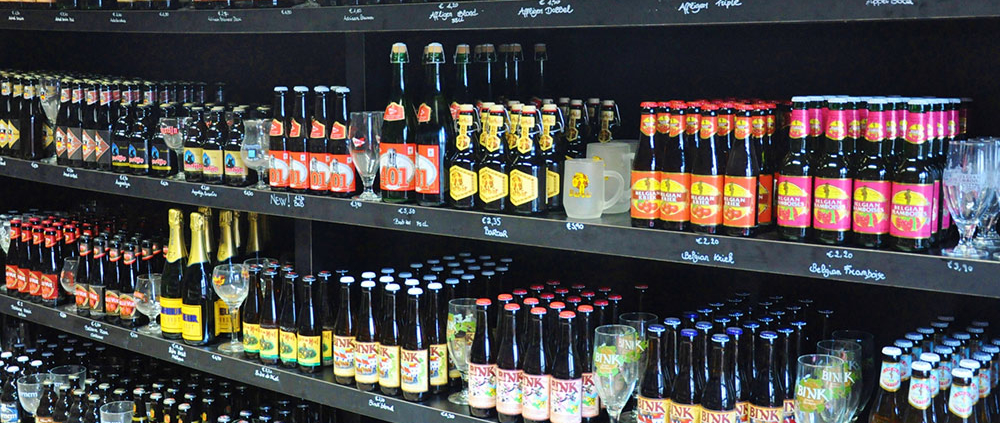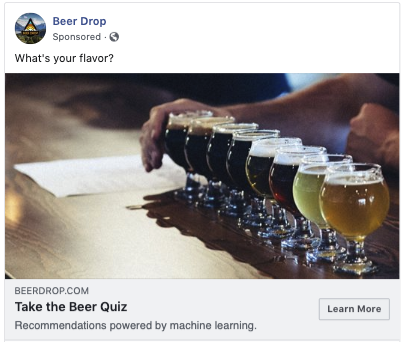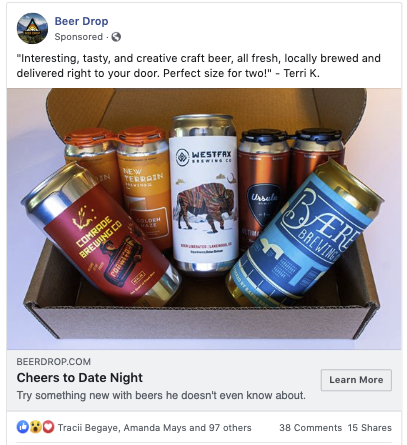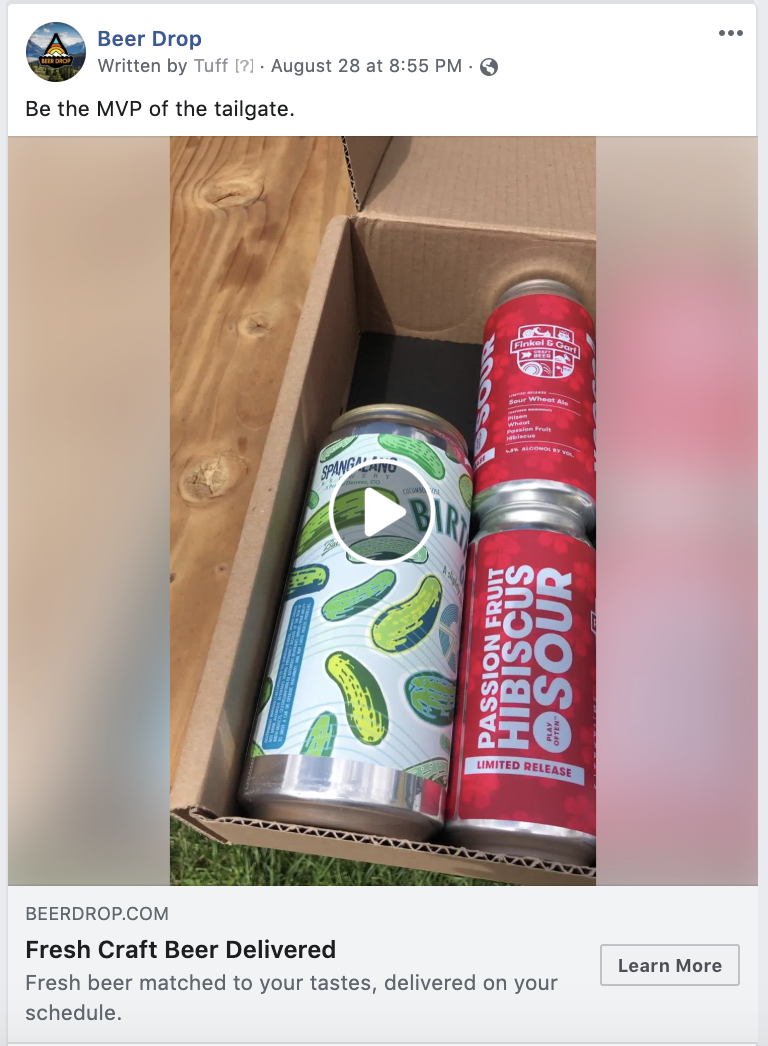How To Run Paid Acquisition Campaigns For Your Subscription Business
We sometimes get questions about how other clients work with Tuff to reach their growth goals — so we’re sharing some stories to help bring our services to life. Meet Beer Drop.
Beer Drop is an all Colorado beer subscription delivering only the freshest beers from Colorado’s best small breweries you won’t find in stores.
As a growing business, Beer Drop came to Tuff looking for a growth marketing partner that would help scale customer acquisition leveraging ppc and paid social. With clear goals and an aggressive testing plan, we’ve worked closely with Beer Drop to continually hit our growth goals and customer acquisition targets. The Beer Drop team works strategically on the product while the Tuff team is responsible for executing growth strategies that deliver quality traffic. This combination, so far, has been pure magic.
- In the first month, we started slow. We focused on audience research, targeting, and message development. We validated that Facebook and Google were the right fit for Beer Drop and could successfully deliver subscribers.
- In the second month, we tripled our budget and went for scale. We expanded our geo-targeting, introduced video, and refined the sign up flow.
From initial launch to today, as an integrated team, we’ve been able to increase subscriptions by 531% while simultaneously driving down cost per subscription by 61%.
Building and optimizing a customer acquisition strategy on Facebook and Google to get results like this is not easy. It’s not rocket science either, though. If your execution is data-driven and marketing and product can work as one, you can see results like this, too.
Talk to your existing customers
When it comes to successful ppc and paid social campaigns, we spend 50% or more of our time understanding what the customers’ needs are. This is so often overlooked but incredibly critical. You have to know who your target audience is, what their problems are, and how they want to interact with you. Having these questions explicitly answered will allow you to build a much stronger customer acquisition strategy on Facebook and Google based on both qualitative and quantitative data.
During this phase, we like to:
- Talk to customers
- Read customer reviews
- Read competitor reviews
- Study social channels and followers
- Follow Google Analytics flows and analyze heatmaps
- Analyze Google Analytics audience data
Test different audiences and messages
When it comes to paid channels, especially Facebook, it’s easy to narrow in on visuals. This is important, absolutely, but don’t get stuck here. It’s more important to test early and often with multiple audiences than to spend weeks on creative development.
At Tuff, for Facebook audiences, we take the 80/20 rule. We launch campaigns with 8+ audiences, find the top performers early and push spend to them, and then kill the rest. We did this with Beer Drop, too. In month one, we launched with 45 audiences across 5 campaigns. In our second campaign launch, we only launched with the top 30% of audiences in phase one.
For Beer Drop, “top performing audiences” meant audiences that purchased subscriptions. This isn’t always the case though. When you are evaluating success and making audience optimizations, you have to link back to your campaign objective. Did you optimize for reach? Did you optimize for clicks? Did you optimize for sales? You need to evaluate campaign performance against the action you told Facebook you care the most about.
Focus on your lowest hanging fruit
If you’re testing the waters with paid social and ppc, if you can focus on the low hanging fruit, do it. With limited time, money, and people, you want to put your best foot forward first. For subscription-based service, that could be:
- People who’ve added stuff to cart and have purchased
- An email list you’re trying to reactivate
- Retargeting audiences to a specific landing page
That said, I’ll be honest, for Beer Drop, we ignored this completely. Beer Drop is based in Colorado and has more brand awareness in this market than any other state in the US. Our initial plan was to experiment with campaigns in Colorado because we thought the existing brand presence would help us convert at a higher rate. We changed directions before launch because of our overall business objectives. We needed to find out if paid acquisition would work in cities and states that had never heard of us before. It’s a balancing act really, how do you pair business objectives with the right experiments to give them the best chance to be successful?
Optimize for subscriptions and not clicks
For Beer Drop, we tested out two types of campaign objectives. We ran a batch of click objective campaigns and a batch of subscription campaigns. This is an important distinction because it influences what optimization and bidding options you have throughout the campaign setup and ultimately how the ads are served.
Our click objective campaigns, example below, we developed around a “quiz” concept where we wanted to drive as much traffic as possible to the quiz, collect an email, and then retarget. The engagement and click stats were bonkers. To no one’s surprise, people love beer quizzes almost as much as they love beer. Although we had incredible results here, we ultimately killed it because it wasn’t helping with our end to get more subscribers at an efficient cost.
Our subscription objective campaigns, example of one of the ads below, were setup using custom conversion event tracking. We place code on the subscription confirmation page and tell Facebook to help us get our ads in front of people likely to subscribe. This doesn’t always work for newer brands or startups like Beer Drop but for us, because of our data-driven target and user-specific copy, it worked.
Using real photos as social proof
Users have become pretty numb to overproduced videos and fancy creative. A few years ago the conversation with paid, especially Facebook, was “how do we stand out enough to get someone to stop scrolling?” but now, it’s “how do we get more real, more authentic, and blend in with our target audience?”. This is exciting for the small budgets and teams who want to test and experiment often.
Here is a good example. The video below has no editing, took 3 minutes to film, was shot on an iPhone, and ever since launch, has been our best performing ad in almost every campaign:
124 comments and 43 shares in two weeks? Yup, yup! 💪
To get this right, using real photos to drive results, revisit the “Talk to your existing customers” section of this post. It’s the one consistent thing you have to do all the time!
Learn from your traffic and make user flow optimizations
It’s not just about impressions or clicks, right? It’s about driving actions and subscribers. The customer acquisition equation is only complete when we focus as much on pre-click as post-click (and engagement and retention but let’s stick with acquisition for now!).
When someone clicks on your Google ad or Instagram ad, what happens next? We like to use tools like Hotjar, Heap, and Optimizely to learn what users are doing when we actually get them to landing page or website. How can we make things more clear on the page, provide the right value, and remove friction?
Beer Drop’s product team led the charge here. They’ve made small tweaks and adjustments at every stage of the user flow over the course of the last few minutes which has inched our conversion rate up and up. We would never see this type of growth, a 531% increase in MoM subscribers, without a product team committed to user improvements.
When it comes to paid social and ppc, remember that 90% of your traffic from these channels will be on mobile. Review your page in mobile, design in mobile, and make improvements based on mobile behavior.
Use enough budget to test and get data to make better decisions
There’s no one set budget for starting out on Facebook and Google. When we think about test allocations, we start with the goals: “What do I want to learn from my paid advertising? What is the end goal?
In the first phase with Beer Drop, we set out to answer:
- What are my users responding to?
- Can I prove market fit on Facebook?
We’ve seen that in order to answer questions like this, that you need daily budgets in the $200 to $400 a day range to get meaningful data. And be prepared, the early months are often not very profitable. I know everyone wants results, heck I’d be lying if I didn’t say Tuff is driven solely by results, but the trick is to have a smart testing plan to get data that’s statistically significant to your paid social and ppc efforts. What you prove on $100 in spend is not significant enough to say that it’s going to be the same if you spent $10,000.
Whether you’re just testing the waters or ready to scale, figuring out how to acquire new customers on Facebook and Google is difficult. We’ve spent the past few years working with all kinds of different businesses, with small and large budgets, across a range of industries to help them figure this out. We’re still partnering with Beer Drop closely and will update this post with future results, challenges, success stories, and more.
In the meantime, if you want to explore more about how to scale your customer acquisition with Tuff, or want a first-hand look at the data showcased above, touch base to set up a free, 30-minute growth strategy session with our team. We’d love to learn more about who you are and what you do so that we can help you find your way to the next level.
We’d love to work with you.
Schedule a call with our team and we’ll analyze your marketing, product, metrics, and business. Then, present a Growth Plan with actionable strategies to find and keep more engaged customers.

Ellen is the founder at Tuff and one of the team’s core growth marketers. She is a versatile marketer with expertise in multiple channels – from ppc to seo to email to others – responsible for the experiments and testing. She is happiest when she’s on the ski hill or outside pointing her mountain bike downhill.









